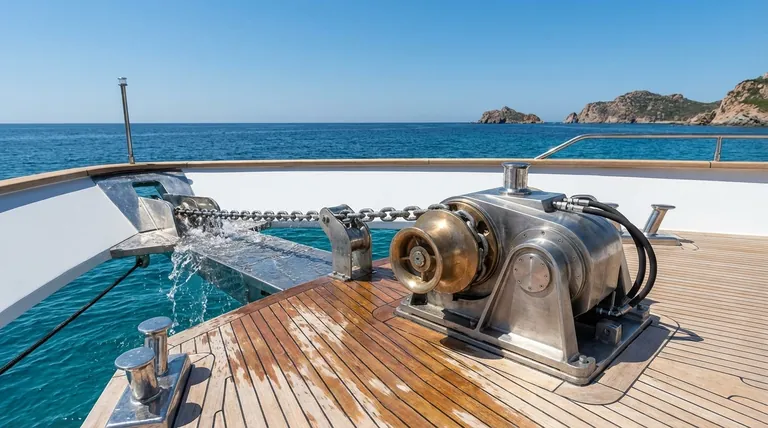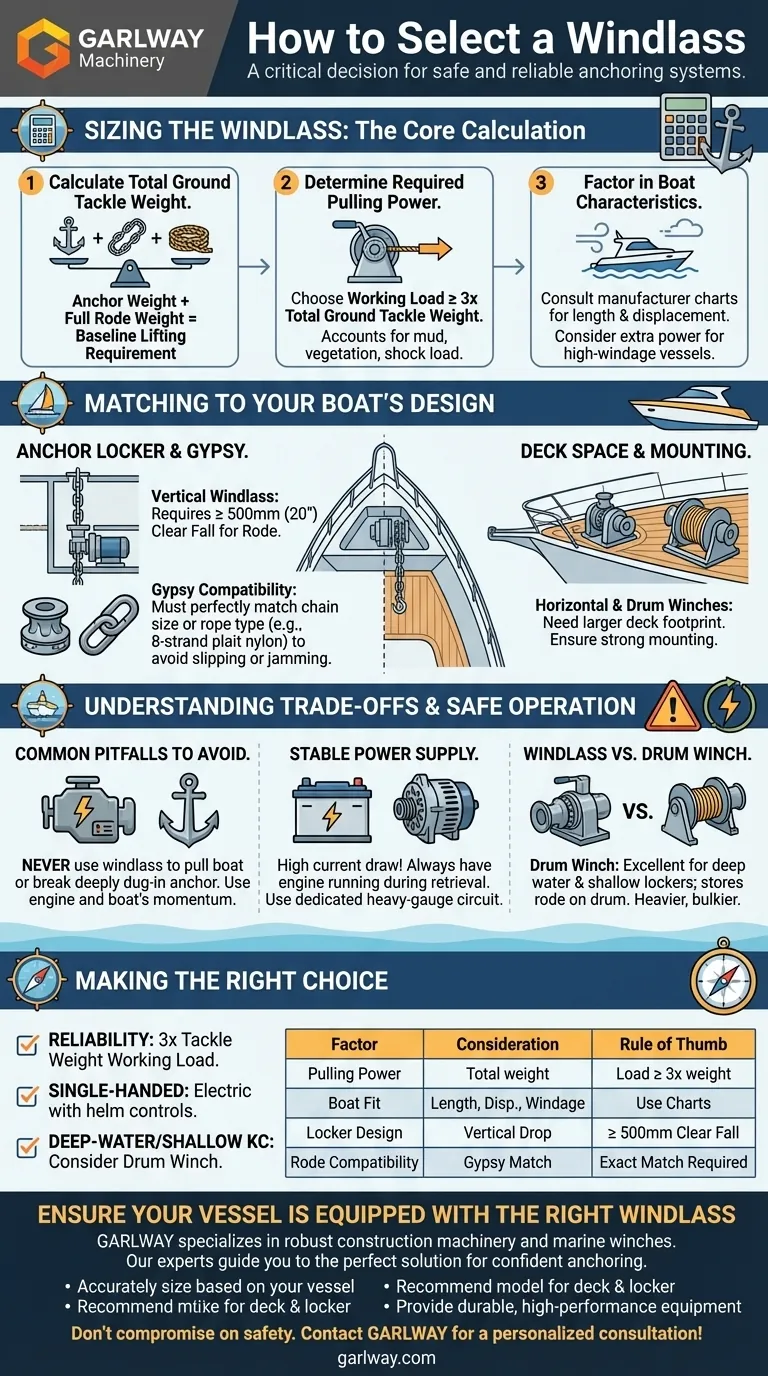Selecting the right windlass is a critical decision based on matching its power and design to your vessel's specific characteristics. You must calculate the total weight of your ground tackle (anchor and rode), factor in your boat's displacement and windage, and then ensure the windlass's physical form factor fits the available space in your anchor locker and on your deck.
A windlass is designed to lift the dead weight of your anchor and rode, not to pull your boat against wind and tide. Sizing it based on the actual load it will lift—and operating it within that limit—is the key to a safe and reliable anchoring system.

Sizing the Windlass: The Core Calculation
The most common point of failure for a windlass is being undersized for the job. The selection process must begin with a clear understanding of the forces involved.
Step 1: Calculate Your Total Ground Tackle Weight
Your windlass must, at a minimum, be able to lift your entire anchor and rode as dead weight out of the water.
Start by adding the weight of your anchor to the full weight of your chain or rope rode. This combined figure is your baseline lifting requirement.
Step 2: Determine the Required Pulling Power
The "working load" of a windlass should be significantly higher than your baseline ground tackle weight to account for real-world conditions.
A widely accepted rule of thumb is to choose a windlass with a working load capacity of at least three times your total ground tackle weight. This surplus capacity provides the power needed to handle mud, vegetation, and the initial shock of breaking the anchor free from the seabed.
Step 3: Factor in Your Boat's Characteristics
While the windlass shouldn't pull the boat, its overall size and windage place additional stress on the system during anchor retrieval in challenging conditions.
Manufacturers provide charts that match windlass models to boat length and displacement. Use these as a guide, but always cross-reference them with your ground tackle calculation. If you have a high-windage vessel like a catamaran or a high-sided powerboat, consider stepping up one size.
Matching the Windlass to Your Boat's Design
Once you have determined the necessary power, you must select a model that physically integrates with your boat.
The Critical Role of the Anchor Locker
The design of your anchor locker is often the deciding factor in what type of windlass you can install.
A vertical windlass, where the motor is below the deck, requires a significant amount of vertical drop for the rode to self-stow without piling up. A minimum of 500mm (about 20 inches) of clear fall from the underside of the deck to the top of the stowed rode is essential.
Choosing the Right Gypsy for Your Rode
The gypsy is the notched wheel that grips the anchor rode. It is absolutely critical that the gypsy is perfectly matched to your specific chain size or rope type.
A mismatch will cause the rode to slip under load or jam during retrieval, rendering the windlass useless and creating a dangerous situation. If using rope, it must be a specific type, such as 8-strand plait nylon, that can be gripped effectively.
Deck Space and Mounting Considerations
Consider the available space on your bow. Vertical windlasses have a smaller on-deck footprint, but drum winches and some horizontal windlasses require significant surface area.
Ensure the deck is strong enough for the mounting bolts and the high loads the windlass will exert. Reinforcement may be necessary.
Understanding the Trade-offs
No single windlass is perfect for every situation. You must weigh the advantages and disadvantages of each style.
Common Pitfalls to Avoid
A windlass is a powerful tool that must be operated correctly to ensure its longevity and your safety.
Never use the windlass to pull the boat forward to the anchor; use your engine to motor gently over the anchor's position. Similarly, do not use the windlass to break a deeply dug-in anchor free. Instead, secure the chain with a chain stopper and use the boat's momentum to dislodge it.
The Importance of a Stable Power Supply
Electric windlasses draw a very high current. Always have your engine running when retrieving the anchor to ensure the alternator can keep up with the demand and your batteries are not depleted.
A dedicated, heavy-gauge circuit with a proper breaker is non-negotiable for a safe and reliable installation.
Windlass vs. Drum Winch
For deep-water anchoring or for boaters who prioritize simple operation, a drum winch can be an excellent alternative.
Drum winches are heavier and bulkier but store the entire rode neatly on a large drum, eliminating any chance of the rode piling up in the anchor locker. This is a significant advantage in boats with shallow lockers.
Making the Right Choice for Your Goal
Your ideal windlass is the one that best aligns with your boat, your gear, and your style of boating.
- If your primary focus is reliability: Prioritize an accurate calculation of your ground tackle weight and choose a windlass with a working load of at least 3x that weight.
- If your primary focus is single-handed sailing: An electric windlass with controls at the helm is essential for safe and efficient operation without leaving your post.
- If your primary focus is deep-water anchoring: Strongly consider a drum winch, which excels at managing long rodes without the risk of jamming in the anchor locker.
- If your primary focus is a boat with a shallow anchor locker: Measure your vertical fall carefully. A horizontal windlass or a drum winch will likely be a better fit than a vertical model.
A well-chosen windlass is not a luxury; it is the foundation of a safe and confident anchoring system.
Summary Table:
| Selection Factor | Key Consideration | Rule of Thumb |
|---|---|---|
| Pulling Power | Calculate total anchor & rode weight. | Choose a windlass with a working load ≥ 3x total weight. |
| Boat Fit | Match to boat length, displacement, and windage. | Use manufacturer charts as a guide, especially for high-windage vessels. |
| Locker Design | Measure vertical drop for the rode. | Vertical windlass needs ≥ 20 inches (500mm) of clear fall. |
| Rode Compatibility | Gypsy must match chain size or rope type exactly. | A mismatch causes dangerous slipping or jamming. |
Ensure Your Vessel is Equipped with the Right Windlass
Selecting the correct windlass is critical for the safety and efficiency of your operations. At GARLWAY, we specialize in providing robust and reliable construction machinery, including winches and other heavy-duty equipment built for demanding environments. Our expertise in power and durability translates directly to marine applications, ensuring your windlass can handle the load.
We can help you:
- Accurately size a windlass based on your specific vessel and ground tackle.
- Recommend a model that fits your deck space and anchor locker design.
- Provide equipment known for durability and high performance under load.
Don't compromise on safety. Let our experts guide you to the perfect solution for confident anchoring.
Contact GARLWAY today for a personalized consultation!
Visual Guide

Related Products
- Heavy Duty Electric Boat Winch Windlass Anchor
- Warn Winch Windlass Boat Trailer Winch
- Electric Hoist Winch Boat Anchor Windlass for Marine Applications
- Ready Mixer Machine for Construction Ready Mix Machinery
- Portable Cement Mixer with Lift Concrete Machine
People Also Ask
- What is the difference between anchor windlass and mooring winch? Essential Guide for Marine Equipment
- How does a boat anchor winch work? A Guide to Reliable Anchor Handling
- What are some challenges with windlass type winches? Key Issues in Rode Matching and Operation
- How much current does an electric boat winch draw? Plan Your Electrical System for Peak Performance
- How do electric boat winches work? Unlock Effortless Launching & Retrieval


















